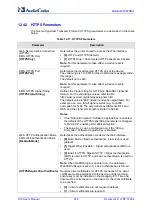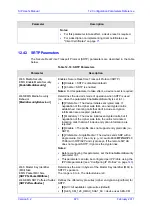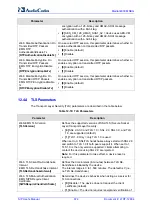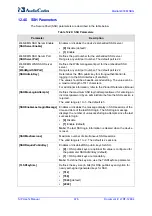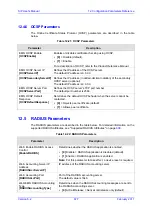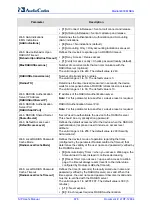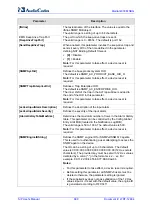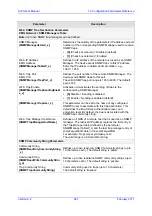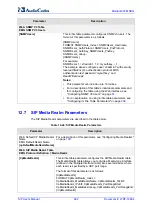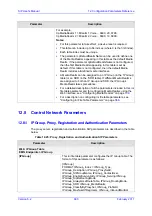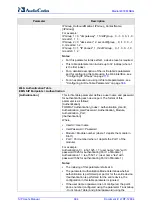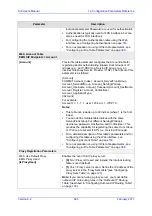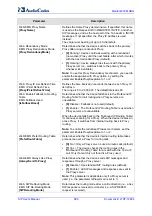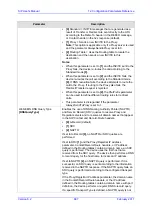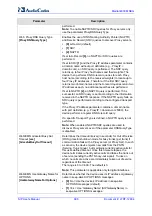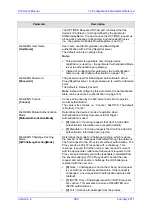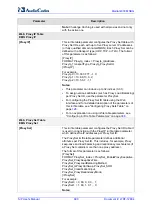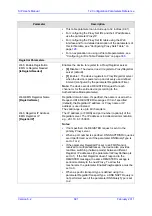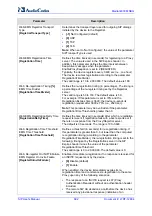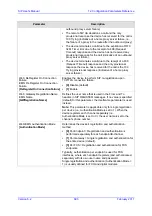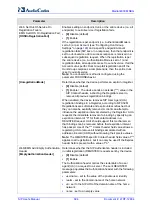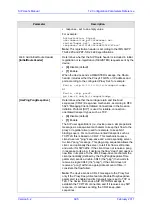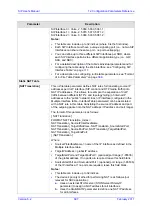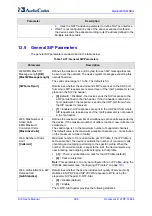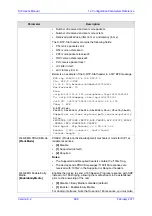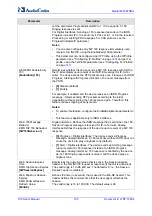
SIP User's Manual
686
Document #: LTRT-12804
Mediant 800 MSBG
Parameter
Description
Web/EMS: Proxy Name
[ProxyName]
Defines the Home Proxy domain name. If specified, this name
is used as the Request-URI in REGISTER, INVITE, and other
SIP messages, and as the host part of the To header in INVITE
messages. If not specified, the Proxy IP address is used
instead.
The value must be string of up to 49 characters.
Web: Redundancy Mode
EMS: Proxy Redundancy Mode
[ProxyRedundancyMode]
Determines whether the device switches back to the primary
Proxy after using a redundant Proxy.
[0]
Parking = device continues working with a redundant
(now active) Proxy until the next failure, after which it works
with the next redundant Proxy (default).
[1]
Homing = device always tries to work with the primary
Proxy server (i.e., switches back to the primary Proxy
whenever it's available).
Note:
To use this Proxy Redundancy mechanism, you need to
enable the keep-alive with Proxy option, by setting the
parameter EnableProxyKeepAlive to 1 or 2.
Web: Proxy IP List Refresh Time
EMS: IP List Refresh Time
[ProxyIPListRefreshTime]
Defines the time interval (in seconds) between each Proxy IP
list refresh.
The range is 5 to 2,000,000. The default interval is 60.
Web: Enable Fallback to Routing
Table
EMS: Fallback Used
[IsFallbackUsed]
Determines whether the device falls back to the 'Outbound IP
Routing Table' for call routing when Proxy servers are
unavailable.
[0]
Disable = Fallback is not used (default).
[1]
Enable = The 'Outbound IP Routing Table' is used when
Proxy servers are unavailable.
When the device falls back to the 'Outbound IP Routing Table',
it continues scanning for a Proxy. When the device locates an
active Proxy, it switches from internal routing back to Proxy
routing.
Note:
To enable the redundant Proxies mechanism, set the
parameter EnableProxyKeepAlive to 1 or 2.
Web/EMS: Prefer Routing Table
[PreferRouteTable]
Determines whether the device's internal routing table takes
precedence over a Proxy for routing calls.
[0]
No = Only a Proxy server is used to route calls (default).
[1]
Yes = The device checks the routing rules in the
'Outbound IP Routing Table' for a match with the Tel-to-IP
call. Only if a match is not found is a Proxy used.
Web/EMS: Always Use Proxy
[AlwaysSendToProxy]
Determines whether the device sends SIP messages and
responses through a Proxy server.
[0]
Disable = Use standard SIP routing rules (default).
[1]
Enable = All SIP messages and responses are sent to
the Proxy server.
Note:
This parameter is applicable only if a Proxy server is
used (i.e., the parameter IsProxyUsed is set to 1).
Web: SIP ReRouting Mode
EMS: SIP Re-Routing Mode
[SIPReroutingMode]
Determines the routing mode after a call redirection (i.e., a 3xx
SIP response is received) or transfer (i.e., a SIP REFER
request is received).
Summary of Contents for Mediant 800 MSBG
Page 2: ......
Page 366: ...SIP User s Manual 366 Document LTRT 12804 Mediant 800 MSBG Reader s Notes ...
Page 372: ...SIP User s Manual 372 Document LTRT 12804 Mediant 800 MSBG Reader s Notes ...
Page 390: ...SIP User s Manual 390 Document LTRT 12804 Mediant 800 MSBG Reader s Notes ...
Page 404: ...SIP User s Manual 404 Document LTRT 12804 Mediant 800 MSBG Reader s Notes ...
Page 616: ...SIP User s Manual 616 Document LTRT 12804 Mediant 800 MSBG Reader s Notes ...
Page 636: ...SIP User s Manual 636 Document LTRT 12804 Mediant 800 MSBG Reader s Notes ...
Page 652: ...SIP User s Manual 652 Document LTRT 12804 Mediant 800 MSBG Reader s Notes ...
Page 886: ...SIP User s Manual 886 Document LTRT 12804 Mediant 800 MSBG Reader s Notes ...

